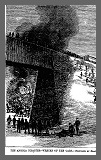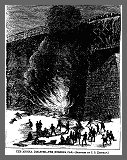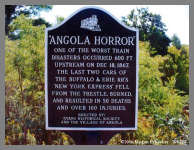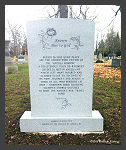Wednesday, December 18, 1867, synonymous with Angola, New York, is a date which will live in infamy as Angola is the site of one of the nation's worst train disasters that became known as the "Angola Horror". It could not have happened at a worse time, as everyone's thoughts were on the rapidly approaching Christmas holiday!
The "New York Express" which traveled over the rails of the Lake Shore and Michigan Southern Railway Line from Chicago, with connections at Buffalo over the New York and Hudson River Railroad to New York City and Boston, was due to pass through Angola, New York, about 21 miles west of Buffalo, at 1:25 P.M. There were conflicting reports as to why the train was two hours late. Newspaper accounts mention both heavy opposing traffic and a derailment of another train to the west. The Express didn't pass the Angola station until 3:11 P.M. Angola was not a station stop for this train. At the throttle was veteran engineer Charles Cascadin. The train consisted of three First Class cars and one Second Class car. Ahead of these cars were three baggage cars. The man in charge of the train was conductor Frank Sherman. At Angola, New York, station agent J. M. Newton and telegrapher John S. Taggert were on duty.
 |
"The Buffalo Commercial Advertiser of December 19, 1867 recorded the following graphic detail: "About a quarter of a mile, or it may be a trifle less, this side of the station is a small stream called Big Sister Creek, over which there is a trestle-work bridge of some one hundred and twenty-five feet, the roadway being between sixty and seventy feet above the water." ref. 1
|
"At a point a loosened axle threw the rear car, a few rods west of the bridge, from the rails as it crossed a frog switch, throwing the wheels on one side of the car an inch or more out of their proper position. The wheels on one side of the car ran over the ties, and those (wheels) on the other side, upon the bridge, crashing through the decking and breaking some of the ties."
"The rear car was dragged in this position to the opposite side of the bridge at which place the descent was the greatest. It was when the coupling by which it was attached to the other car parted and it plunged end foremost down the declivity, turning over, it is said, two or three times and resting on the bank of the creek."
"The other car (second from the rear) did not leave the track until a distance of something like one hundred and fifty feet had been reached, when the coupling to that also parted, and it was hurled down the embankment on the opposite side. This car also turned over in the descent and rested on its side."
|
| "The most shocking of the disaster was the fate of those in the rear car. When the can went down the embankment, the pot-bellied stoves at both ends were overturned, the red hot embers spilling out setting fire to the coach (of wooden construction), and twenty three human beings were literally burned alive, while fifteen others were crushed to death. Their cries for help were truly heart rendering. The car was totally consumed, but (with only) two of all the number inside escaping. None of those who perished could be recognized. The remains were gathered up and taken to the freight house and placed upon boards to await the arrival of coffins, which had been ordered from Buffalo by authorities of the railroad. |
 |
"The embankment was not so high at the spot where the second car went over, but two of the passengers were killed, almost all were injured, some of them it is feared fatally.
"The news of the accident spread like wild-fire and soon a goodly number of the inhabitants of Angola were at the scene. The wounded were released from the wreck of the car with the utmost possible speed and borne to homes nearby, and rendered as comfortably as possible.
"Both the President, Mr. Williams, and Superintendent Brown of the railroad were advised by telegraph of the disaster, and immediately sent for Drs. Pratt, Von Guysiling, Johnson, Wetmore, Blanchard, Richards, Diehl and others to attend to the wounded. Drs. Pratt, Von Guysiling and Barnes remained at the National Hotel on Exchange Street to receive and care for those who were brought to the city by a later train while the others-named, accompanied by Mr. Williams and Mr. Brown, set out for Angola, where they arrived about 5 P.M. Dr Curtiss of Angola was also assisting, as was Dr. Hoyer of Tonawanda, who was on the train when the accident happened, being on the second to last car, fortunately escaping with a trifiling bruise. All these gentlemen assisted by the fine villagers, men and women of Angola, worked in binding up the wounds, and relieving, as far as skill could relieve, the suffering of the wounded."
"Those actively rendering assistance from Angola at the wreck site included: Sheriff Caskey, Mr. Henry Bundy, Mr. Isaiah Southwick, Mr. Stephen West, Frank Griffith and others. The officers of the railroad were most active, kind and efficient, and spared no effort to promote the comfort of those who were hurt, or to secure proper disposition of the dead."
"The news of the disaster reached the City of Buffalo, and a large number of persons quickly congregated at the Exchange Street Depot. Among them being many who had, or feared that they might have, friends or relative among those killed or maimed."
"About 9 P.M., the Cincinnati train arrived at the depot, bringing a number of wounded. Some of whom were conveyed to the National Hotel, some to the Tifft House and some to the Buffalo General Hospital. All received prompt attention and such assistance as it was possible for the physicians to render."
"About two thousand people assembled at the Exchange Street Depot the following morning an hour before the Erie Accomodation train arrived at mid-morning. Among those present were anxious and inquiring persons who had either relatives or friends on the ill-fated train yesterday."
"Buffalo Police Captain Nicholson with a squad of officers, upon the train's arrival, cleared the depot of the crowd, and admirable order was preserved at all times."
"Erie County Coroner Jesse J. Richards came down to the train and supervised the removal of the coffins to the Old Soldier's Home, nearly opposite the main entrance to the depot. A large number of people lined the walks while the bodies were being carried out of the depot, and a most respectful silence was observed."
"The dead, thirty nine of them (final count was 42) - were borne into the Home and the coffins were placed in a row on the floor, where they will remain. The bodies will be prepared for internment and await the action of the Coroner and the application of friends. The visitors withdrew, the doors were closed, with officers on guard, and the dead were left alone, save the attendants in charge." ref. 2
A third train comprised of one sleeping car, arrived at the depot around 1 P.M. that afternoon, with scores of people on hand seeking information. The few remaining uninjured would be brought to Buffalo the following day.
On Sunday, December 22, 1867, a memorial service was held at the Exchange Street Station for all the unclaimed victims of the "Angola Horror".
Erie County Coroner Jesse J. Richards presided over a Special Board of Inquiry, which began its work immediately on December 20, 1867, with a jury composed of George D. W. Clinton, Charles E. Young, William Douglass, Henry N. Hoyt, J. H. Seward and Charles H. Durkee. The first order of business was a trip to Angola to get a first-hand feel for what had happened, and to interview local residents and railroad employees. Most of the testimony, which concluded on December 31, 1867, took place in Buffalo.
|
Among those giving eye-witness testimony were several people aboard the ill-fated train as well as local railroad employees and management officials. A number of Angola residents who resided near the railroad and those about their daily work in the village or in the fields, also relater what they had seen.
On the last day of the Inquest, it was revealed in testimony by a Railroad switchman, that there was indeed a broken rail in the frog or switch found that morning, but it had been replaced and everything seemed in order as several trains had passed over the spot before the New York Express.
After the derailment, "Some of the spikes were cut off, and others drawn out, and the rail was twisted; one side of the rail was also nicked; the bottom of the rail from the tie was up about one inch or more from the tie where the cars had left the track." ref. 3
The issued final report stated the cause of the derailment was the use of an extremely dangerous makeshift known as a "compromise car". Compromise cars came into being because the track gauges (width from rail to opposite rail) of the New York Central Railroad was 4 feet 8-1/2 inches. The gauge of the Lake Shore railroad was 4 feet 10 inches. While a car could run safely over the New York Central, the wheels of a Lake Shore car were 3/4 inch short of the rail. Any lateral (side to side) motion that threw the wheels off center could derail a "compromise car". The imperfect frog in the switch as the compromise car passed over that point, was a contributing factor.
Compromise cars were immediately thereafter withdrawn from service!
An interesting fact of history, only recently revealed, was that John D. Rockefeller, then age 26 and not widely known outside of Cleveland, Ohio, where he resided, and who had not yet founded the Standard Oil Company (1870) which would make him one of the richest men in the world of the 19th Century, was scheduled to be a passenger on that ill-fated train heading for New York City. Running late, he had forwarded his luggage to the railroad station on time, but missed the train, and boarded the following train. Had he been on time, he would likely have perished in the wreck. While stopping in Angola, he managed to telegraph his wife that he was well, and thanking God for saving his life.
Although the "Angola Horror" happened 151 years ago, a suitable marker was never placed near the spot as a remembrance to those who perished. This oversight was corrected on August 27, 2008, when a marker was dedicated at the Mill Street bridge by the Evans Historical Society with officials from the Village of Angola in attendance. A second marker will be placed in Buffalo's Forrest Lawn Cemetery as a memorial to at least 17 unknown deceased passengers buried in an unmarked mass grave. An exhibit dedicated to the "Angola Horror" including a statue of John D. Rockefeller, will be erected in the Village of Angola on Commercial Street.
|
FOOTNOTES:
1. "The Railroad Horror', Buffalo Commercial Advertiser, December 21, 1867, page 2
2. "Appalling Disaster", Buffalo Commercial Advertiser, December 19, 1867, page 3
3. "The Late Railroad Disaster", Buffalo Commercial Advertiser, December 24, 1867, page 3
4. Vogel, Charity, "The Angola Horror" , American History, February, 2008, Pages 50-58
5. Vogel, Charity, "Rail tragedy too horrible to be forgotten", The Buffalo News, Jan. 21, 2008, page B1
6. Pignataro, T.J., "Angola memorializes the victims of 18678 train disaster", The Buffalo News, Aug. 28, 2008, page B1.
Editors note: This accident was the stimulus that led the young George Westinghouse (born 1846 in Central Bridge, N.Y.) to the development of the air brake for trains (think: "WABCO"). Cornelius Vanderbilt, President of the New York and Hudson River Railroad, dismissed the concept, not believing that you could stop a train by "blowing air". Westinghouse, who received his first patent at age 15, was also the inventor of the railroad "frog". |
FOLLOW - UP: by smph50
It took many years for the victims and families of this terrible tragedy to get a proper memorial of their deaths. Their passing was finally recognized on August 28, 2008. |
 |
The Angola Village Board and the Evans Historical Society with help provided by Erie County and the Town of Evans, erected a cast black metal marker trimmed in gray at the corner of Mill Street and Gowans Road. "We hope it's here forever documenting history," said Gifford Swyers, a member of the Town of Evans Historical Society. "We dedicate this to the victims of the Angola train disaster." ref. 6
"The Buffalo News" staff reporter T. J. Pignataro was on hand to document the event. |
| Eight years later on May 12th, 2016, the unknown remains of at least 17 victims were properly honored by the "Friends of the Village of Angola" at Forest Lawn Cemetery. "Monument to Victims of the "Angola Horror" A special ceremony was held on Saturday, May 14 at 10:00 a.m. to dedicate the monument to the 49 men and women who lost their lives in the accident that occurred more than 151 years ago. The monument is placed at the unidentified victims' gravesite. |
 |

This page was last updated: February 23rd, 2018
Web Site Hosting by TRAIN WEB
The WNYRHS, Inc. P.O. Box 416, Buffalo, NY. 14231-0416 is an independent organization and has no affiliation with any other local or national group.
The Society is a fully qualified organization under 501 (C) (3) of the Internal Revenue Code and all donations to the Society are tax deductible.
©Copyright 1999 , WNYRHS Inc. all rights reserved
 Web Design & Hosted by - Scott H. Web Design & Hosted by - Scott H.
|